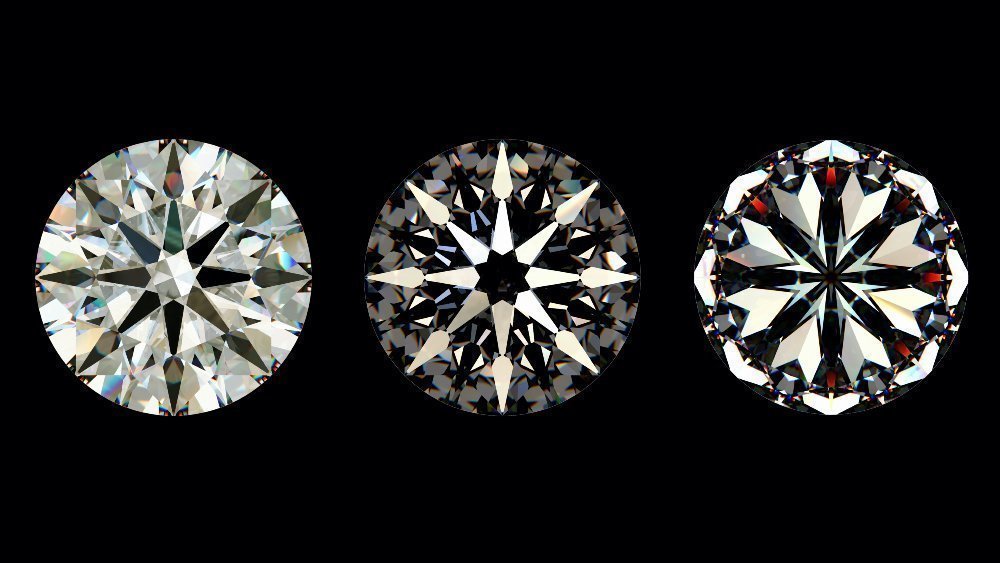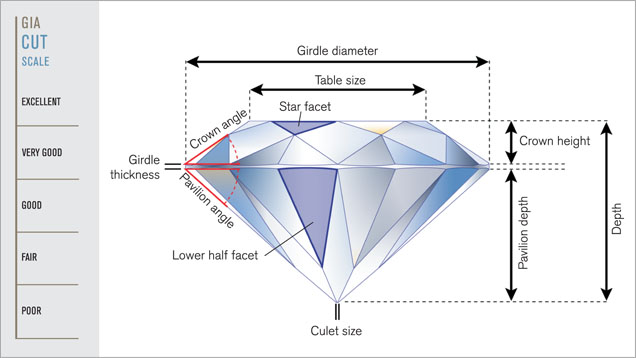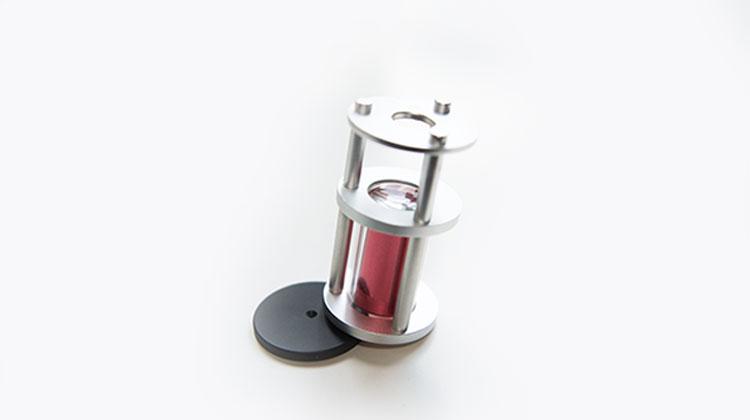Hearts And Arrows
The original Hearts and Arrows were diamonds that surfaced in the mid 1980s in Japan that embodied three important design factors. The first of these factors was that they were cut to what is known in the diamond industry as “ideal proportions,” i.e. very close to those summarized by Marcel Tolkowsky in his 1919 book, Diamond Design. Second, they were cut with very good physical and optical symmetry so that they would garner the grade of “Excellent” in the system used by Japanese laboratories. The third important factor was that they were cut to a very specific brilliant scheme to produce the accepted hearts and arrows pattern. This faceting scheme involves prescribed lengths and ratios as well as smaller table sizes that are imperative in producing a distinctive, repeatable and gradable hearts and arrows pattern. Less than 1% of the world’s diamonds are cut to hearts and arrows optical symmetry precision. This is in large part due to the greater amount of rough diamond that necessitates additional polishing to create diamonds with this precise optical symmetry. Diamond polishers take up to three times longer to cut diamonds of this cut quality, with much greater waste of the original diamond rough material. Using specialized tools and high quality cutting wheels and in some cases 100X magnification, factories must employ careful analysis through every stage of production. Diamonds cut in this way are more expensive than average cut diamonds.


In the early 1990s, Hearts and Arrows (aka H&A) began to appear in America, they were much more high-tech than the grading labs were. When GIA began to encounter H&A diamonds, several key characteristics were noted in the report. The diamonds were extremely round, tables were 55-57%, the girdles were medium or thin to medium and polish and symmetry were graded excellent. This kind of consistent cutting was unheard of at the time and cut grading did not exist yet in America. HRD (Hoge Raad voor de Diamant) applies objective criteria and uses an automatic measuring device developed in-house to determine whether a diamond meets the stringent Hearts & Arrows standard. IGI (International Gemological Institute) is also one of the laboratories that certify Hearts and Arrows. The WTOCD (Wetenschappelijk technish Onderzoeks Centrum voor Diamant) is one of the most important scientific and technical research centers for diamonds. A proprietary software was developed by WTOCD to analyze the images according to the H&A by HRD Antwerp guidelines. Based on measurements of the H&A patterns, an expert system makes an evaluation of the guidelines. The system delivers consistent, objectively measured, H&A grades.Diamonds with a Hearts and Arrows cut command a price premium in the world’s market, reflecting the generally greater time needed to produce them and the greater loss of weight from rough, as well as their generally better overall cut quality. It has also become a popular sales tool in diamond marketing. Although the «Hearts and Arrows» property is indicative of a top-tier cut, it does not always mean the diamond will be the most brilliant, and should be looked at in conjunction with the cut grade. However, a Hearts and Arrows grading in conjunction with Excellent or Ideal cut grade will give a superb sparkle.

Hearts And Arrows Labeling
Some in the diamond industry disagree on which diamonds should receive the “Hearts and Arrows” label. Because there used to be no industry standard, one person or company may say a diamond is a Hearts and Arrows diamond while another may say it is not. In the industry, the term “super ideal” is a common term that is coined and used to describe diamonds displaying perfect optical symmetry. Most diamonds with an overall cut graded by GIA as “Excellent” (with Excellent symmetry as well) or American Gem Society as “0” (or “Ideal”) will have some sort of hearts and arrows pattern when seen through a viewer, although the pattern may not be perfect. Many within the diamond industry believe the Hearts and Arrows pattern should be graded, and only those with the top grade should be called Hearts and Arrows.[citation needed] Those people believe that the mere presence of a Hearts and Arrows pattern is not sufficient to be considered a Hearts and Arrows diamond; the pattern must be perfect to fit within certain guidelines.

It is the pattern of ideal optical symmetry + excellent parallelism, particular lengths of lower girdle facets and major facets, obtained by excellent cut of the the angles of the major facets and the minor facets.

Viewed from the crown, (TOP) the pattern has eight arrows.
Viewed from the pavilion, (BELOW) the pattern has eight hearts.
By special magnifying viewer you can see this.
Diamonds with a Hearts and Arrows cut, are much more expensive.